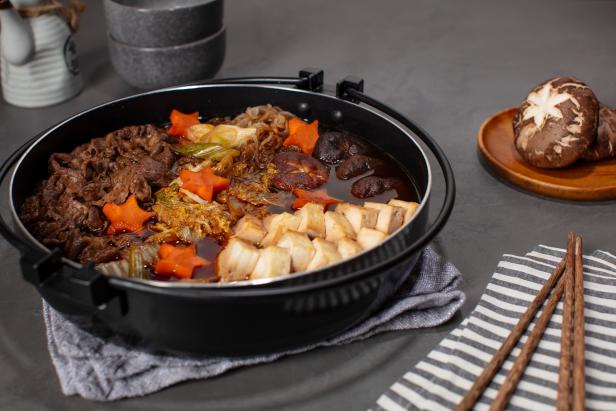There are several types of sukiyaki in Asia, but what they all have in common is being cooked in a pot with broth, which gave them the name hot pot. This is Japanese Kanto-style sukiyaki, which is thin sliced super fatty beef along with vegetables cooked together into a broth. Japanese farmers used to grill (yaki) their beef over their suki (plows), hence the name. Warshita is the mildly sweet, salty and umami sauce that flavors Japanese sukiyaki. I use a little MSG at home but feel free to omit it if not comfortable cooking with it.
| Level: | Easy |
| Total: | 40 min |
| Active: | 40 min |
| Yield: | 4 servings |
Ingredients
- 1/2 cup mirin
- 1/2 cup good quality Japanese dark soy sauce
- 1/4 cup sugar
- 1 teaspoon MSG, optional
- 8 ounces shirataki noodles
- 4 to 6 fresh shiitake mushrooms or 1/4 bunch of enoki mushrooms
- 1 large carrot, peeled
- 2 tablespoons neutral oil, such as canola oil, grapeseed oil or peanut oil, or a 1-inch cube of beef fat
- 1 pound paper thin slices super marbled beef, preferably ribeye
- 1 Japanese green onion or 3 scallions, sliced on a 1/2-inch bias
- 1/2 white onion, cut into 1/4-inch-thick slices
- 9 to 10 ounces firm tofu, cut into 1/4-inch-thick slices
- 1/2 cup Napa cabbage, cut into 3-inch lengths
- 1 to 2 cups water
- 2 to 3 large, pasteurized eggs
Instructions
- For the warishita: Whisk together the mirin, dark soy sauce, sugar and MSG if using in a small bowl until the sugar is dissolved. Set aside.
- For the sukiyaki: Cook the shirataki noodles in a small pot of boiling water over medium-high heat until blanched, 1 minute. Drain, rinse and set aside.
- To cut mushroom stars, hold each shiitake mushroom with the cap-side up and use a paring knife to make a beveled cut straight down the middle. Remove the portion you’ve cut out, so it reveals the white flesh. Repeat on the diagonal twice so that you create a star shape with 4 or 6 points. Set aside.
- To make carrot stars: Cut the carrot into twelve 1/4-inch-thick rounds. Use a mini star-shaped vegetable cutter on each carrot disc to create a star shape if desired, reserving the carrot scraps for another use.
- Place a sukiyaki pot over medium-high heat; I like using the cast-iron lidded type called Iwachi (cast iron) sukiyaki nabe (pot). You can also use a donabe or any soup pot. Something about 4 quarts in size will be perfect.
- Drizzle enough oil to coat the bottom or if using a piece of beef fat, just drag it along the bottom of the pot until it melts and covers the surface.
- Lay the beef flat into the bottom of the pot and quickly sear both sides, leaving the centers rare, 30 seconds to 1 minute per side. Pour the warishita into the pot and stir with a wooden spoon or silicone spatula to deglaze the brown bits on the bottom of the pot and coat the beef. Once the beef is coated, drag and gather the beef to one corner of the pot. Start to arrange each vegetable (the Napa cabbage then the mushrooms, onion, green scallion and carrots), tofu and noodle component into its own little area, like arranging a charcuterie board.
- Now add the water just until it is visible under the vegetables, beef and tofu, DO NOT cover and boil. Stir and gently, cover and simmer until the Napa cabbage and mushrooms are cooked through since they take the longest, 3 to 5 minutes. All the ingredients will create a rich broth.
- Traditionally, you would crack an egg into an individual small serving bowl, scramble and use the egg as a dip for each bite of sukiyaki. Alternatively, you can crack the eggs into the sukiyaki as it simmers to gently poach them after adding the water.
Nutrition Facts
| Serving Size | 1 of 4 servings |
| Calories | 840 |
| Total Fat | 41 g |
| Saturated Fat | 13 g |
| Carbohydrates | 64 g |
| Dietary Fiber | 5 g |
| Sugar | 16 g |
| Protein | 49 g |
| Cholesterol | 241 mg |
| Sodium | 2055 mg |
